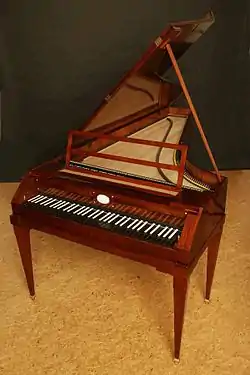Paul McNulty (piano maker)
Paul McNulty is a builder of historical pianos, described by the New Grove as "famous for the high standard of [his] instruments." Within the community of builders, McNulty is noted for his efforts to extend the production of historically informed instruments later into history: while he has built many fortepianos in 18th-century style, he has also progressively sought to span the gap between the fortepiano (the cradle of modern historical-piano construction) and the fully modern piano that emerged around the last third of the 19th century. The expanding diversity of McNulty's productions has thus helped "provide an opportunity to extend keyboard performing practice to include the piano repertory of the 19th century" (New Grove).[1]

Life
He was born in 1953 in Houston, Texas.[2] In 1976 he attended the Peabody Conservatory, studying classical guitar, then became interested in historical instruments, studying lute performance, etc. In 1978 he entered the New England School of Stringed Keyboard Instrument Technology, where he studied under Bill Garlick. At his final examination McNulty gained the highest possible qualification: "tuning examiner".
He attended a seminar at the Steinway factory in New York and was recruited to work there as a technician, but chose instead to embark on a career as a fortepiano builder, and served his apprenticeship for two years under Robert Smith in Somerville, Massachusetts. McNulty's fortepiano was purchased by Norwegian Academy of Music in Oslo. It is worth mentioning that the Austrian pianist Paul Badura-Skoda also placed an order,[3] as did Trevor Pinnock, ordering a fortepiano for a concert at Carnegie Hall.
In 1986 John Gibbons invited McNulty to accompany his European tour with Frans Brüggen's Orchestra of the Eighteenth Century. Gibbons performed Mozart's concertos K.491 and K.466. In the same year McNulty moved to Amsterdam The search for the best materials led McNulty to move to the Czech Republic. It was written that Viennese piano makers preferred to get his soundboards from the Schwarzenberg Forest (now Šumava) in southern Bohemia. Since 1995 McNulty has been living and working in Divišov, a small Czech town. In 2004 he married Russian-Canadian fortepianist Viviana Sofronitsky. In September 2018 McNulty fortepianos Graf copy 1819, Pleyel 1830 and Boisselot 1826 were used in the first International Chopin Competition on Period Instruments (run by Fryderyk Chopin Institute).[4]
McNulty's fortepianos
At present, McNulty builds fortepianos suitable for performances of piano works from Carl Philipp Emanuel Bach, Mozart and Beethoven to Chopin, Liszt and Brahms.
In 2009, McNulty produced the first modern copy of a French piano, a Pleyel, which was Chopin's favorite brand. In 2011, at request of Klassik Stiftung Weimar he reproduced one of Liszt's personal pianos, the Boisselot op. 2800. This instrument was made in 1846 for Liszt's 1847 Russian tour. In 2015 McNulty extended his list of first modern copies with Streicher piano, Brahms' favourite piano model. Brahms was enthusiastic about a piano (op. 6713), that the manufacturer had given him as a present. He wrote of its exquisite qualities to Clara Schumann, advising her to buy one. In 2020 Paul McNulty produced his first Silbermann fortepiano for prof. Malcolm Bilson.[5]
Since 1985 McNulty has made more than 280 pianos, with customers from different countries. USA: Malcolm Bilson, Vladimir Feltsman, Harvard University, Stanford University, Oberlin College; Denmark: Ronald Brautigam; England: Kristian Bezuidenhout, Glyndebourne Festival, Royal Academy of Music (London), Royal College of Music (London); Austria: Nikolaus Harnoncourt, Vienna Volksoper, Wien Konservatorium Privatuniversitat; Australia: Geoffrey Lancaster, Melbourne Recital Center; Poland: Chopin's Institute Warsaw, Warsaw Chamber Opera; Netherlands: Amsterdam Conservatory, the Royal Conservatory of The Hague; Germany: Hochschule für Musik, Theater und Medien Hannover; Switzerland: Schola Cantorum Basiliensis; Finland: Sibelius Academy (Helsinki); China: The Chinese University of Hong Kong, etc.[6]
List of instruments
- Fortepiano after Silbermann 1749
- Fortepiano after Johann Andreas Stein ca. 1788
- Fortepianos after Anton Walter 1790, 1792 and 1805 ca. (Walter & Sohn)
- Fortepiano after J. Fritz 1812
- Fortepianos after Conrad Graf 1819, op. 318; 1822, op. 423 and 1826 ca.
- Fortepiano after Buchholtz 1826
- Fortepiano after Ignaz Pleyel 1830, op. 1555
- Fortepiano after Boisselot 1846, op. 2800
- Fortepiano after Streicher 1868, op. 6747
Further reading
References
- Quotations from the New Grove are taken from the online edition (http://www.oxfordmusiconline.com), article "Pianoforte", section 5, "The Viennese piano from 1800". This section written by Philip R. Belt, Maribel Meisel, and Gert Hecher.
- Fedorovich, Elena. "Vozvrashaya golosa ushedshikh epokh". Cite journal requires
|journal=(help) - Hradecká, Anna Marie. "Paul McNulty: Každý nástroj má svou vlastní osobnost". Opera plus. Retrieved 30 November 2020.
- Moran, Michael. "Final Report and Highlights of the 1st International Chopin Competition on Period Instruments. Warsaw 2–14 September 2018". Retrieved 8 January 2021.
- "Silbermann Piano Arrives in Ithaca (UPDATE: Demonstration by Malcolm Bilson)". Retrieved 8 January 2021.
- "OWNERS AND MUSICIANS". Retrieved 8 January 2021.
External links
- Paul McNulty homepage
- Buchholtz piano copy, made by Paul McNulty
- Recreating Mozart-era pianos in Czech wood
- An American resuscitates the pianos of Mozart or Chopin in a Czech village
- Musical time travel
- PAUL MCNULTY & VIVIANA SOFRONITSKY DISCUSS HISTORIC KEYBOARD PRODUCTION AND EARLY MUSIC
- Paul McNulty, one of the most highly respected builders working today
- Ronald Brautigam on historical pianos, made by Paul McNulty
- Brahms' Streicher piano restored by Paul McNulty
- Paul McNulty fortepianos
- Paul McNulty, builder of historical pianos
- An American resuscitates the pianos of Mozart or Chopin
- Paul McNulty is the embodiment of the ideal master, who is summarising the makers from different epochs
- Exploring the sound world of Chopin on period pianos
- Musical time travel: Recreating Mozart-era pianos in Czech wood
- Un Américain ressuscite les pianos de Mozart ou de Chopin dans un village tchèque
- République Tchèque: un Américain ressuscite les pianos de Mozart
- Pleyel 1555 from 1830 copy by Paul McNulty
- Period Pianos - The Fryderyk Chopin Institute'S Collection
- The International Chopin Competition on Period Instruments